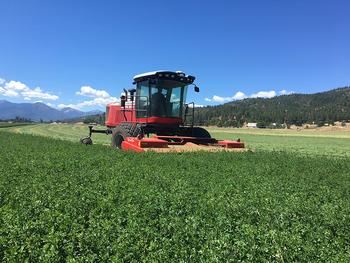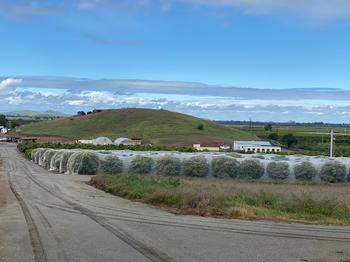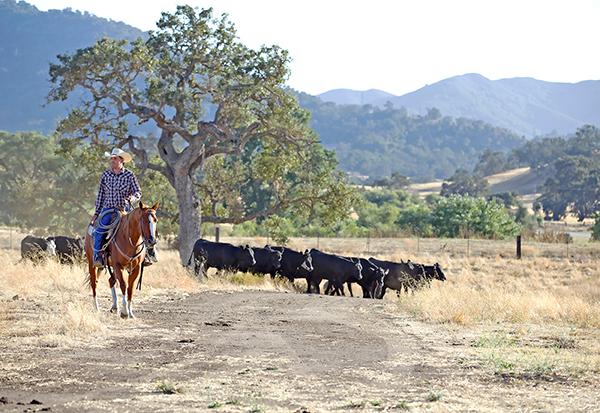Impact Stories
Crop Injury in Alfalfa
Roundup Ready alfalfa has increased in popularity in Northeast California as glyphosate offers excellent control of problem weeds. Considerable research before and after the commercial release of Roundup Ready alfalfa demonstrated essentially no perceptible crop injury from glyphosate. However, starting in 2014, University of California farm advisors received several reports of apparent glyphosate injury to Roundup Ready alfalfa when freezing temperatures followed the application.

Alfalfa trials at Intermountain REC
Research at Intermountain Research and Extension Center (IREC), led by a multi-state research team, was instrumental in narrowing down the cause of the crop injury and defining management options that minimize yield loss. IREC field studies discovered the injury was related to a combination of frost injury and stem blight caused by Pseudomonas syringae. Studies also determined growers can largely avoid the injury symptoms and first cutting yield loss by applying glyphosate before alfalfa exceeds 2 inches of spring regrowth. Additional research is currently underway throughout the Western United States to determine the connection between glyphosate and Pseudomonas syringae.
Access to High-Speed WiFi in the Field
In July 2018, the 330 acres of the Kearney Agricultural Research and Extension Center became fully WiFi capable. Partnering with UC-ANR VINE, Bluetown, and Orange, KARE installed, tested, and went live with remote field systems that allow for real-time data monitoring and collection. Using this technology, researchers have been able to do real-time soil moisture monitoring (Fig 1) and infrared monitoring of fields (Fig 2). This technology presents unique opportunities to develop new ways of monitoring plant growth and development under various biotic and abiotic stresses that have only been available in controlled laboratory settings.
Tango Mandarins

Mikeal Roose and his Tangos
When ‘W. Murcott Afourer‘ mandarins are cross-pollinated by other citrus varieties, the resulting fruit is very seedy. Growers who plant this variety net their trees in spring to prevent pollination by bees. Dr. Mikeal Roose, Dept of Botany and Plant Sciences, UC Riverside, irradiated budwood of the ‘W. Murcott Afourer’ mandarin, propagated trees from the budwood, and planted these in the field at UC Riverside. He and Staff Research Associate Tim Williams evaluated fruit from the trees over several years and discovered that one of the trees was producing nearly seedless fruit. Further testing of the variety for its productivity and fruit characteristics at the Lindcove Research and Extension Center and elsewhere led to patenting this variety, which was named ‘Tango’. The ‘Tango’ cultivar, naturally low-seeded, is unaffected by cross-pollination, saving growers the work and expense of netting in the spring. Soon after its patenting in 2007, the Citrus Clonal Protection Program screenhouse protected trees at Lindcove REC, directed by Dr. Georgios Vidalakis and managed by Staff Research Associate Dr. Rock Christiano, have been the source of ‘Tango’ budwood for the citrus industry. Mandarins and mandarin hybrids currently make up approximately 23% of the 262,673 acres of planted citrus acreage in California, and the ‘Tango’ cultivar is 17% of the mandarin acreage. Dr. Roose has developed four other varieties of low-seeded mandarins and is now selecting for low-seeded lemons. Creating seedless varieties of mandarins has been a substantial economic gain for California growers and is heartily welcomed by consumers.
Pest Resistant Mandarin Oranges

Bee netting protecting mandarins from cross pollination
Dr. Jay Rosenheim’s research team, Dept of Entomology and Nematology, UC Davis, has mined thousands of citrus grower and pest control advisor records to look for trends in pest numbers and fruit damage. They discovered that early-season pests of citrus were abundant in ‘Tango’ and ‘W. Murcott Afourer’ orchards, but the level of damage at harvest was very low. Postdoctoral scholar Dr. Bodil Cass and graduate student Hanna Kahl conducted a series of field tests at Lindcove REC and determined that these cultivars of citrus are naturally unattractive to katydids and earwigs that feed on the rind of newly forming citrus fruits. They also found that citrus thrips populations are smaller and less damaging in these cultivars. Previous studies of early-season pest damage had been carried out on navel and Valencia oranges, which are fairly susceptible to these pests. The news about these mandarins is being communicated to growers and pest control advisors through Lindcove REC field days, citrus industry meetings, brochures, and the UC IPM Citrus Pest Management Guidelines website. Citrus industry knowledge of early-season pest aversion to damage of these two mandarin cultivars, which together make up 38% of California mandarin plantings, will significantly reduce pesticide use.




